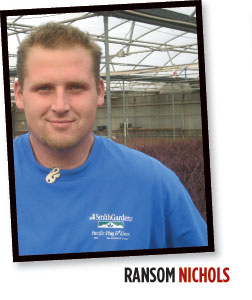5/15/2010
Kick-Starting Kalanchoe
Ransom Nichols

For me, kalanchoe is a crop that I consider to be one of the easiest and hardest things to grow each year. Proper scheduling is very important, and knowing the right time to go to market is key.
Kalanchoe, being a short day-obligate plant, is grown in the fall and the spring here in Bellingham. In the spring, it’s planted alongside our spring crops of chrysanthemums, stock poinsettias and plectranthus. Night interruption lighting during the spring is a must and the lighting schedule fits in with our other lighted crops nicely.
I’ve been growing kalanchoe for four years now and doing a lot of trialing to see what works and what doesn’t. A few things that I’ve learned are that fine-tuning to the desired cultivar is very important. Only by trialing the many different selections that breeders and suppliers have to offer, can you make the right decision on what’s best for your market and your company during any season. For the spring run, we like to have a color pallet in yellows, pinks, creams and other pastels. In the fall, we like to see the autumn colors like red, orange and bright yellow.
Unrooted cuttings work best for us due to the fact that kalanchoe root with humidity in the air. Time and time again I’ve seen cuttings not dibbled in all the way or cuttings that were jostled during the transplant lay down that root right on top of the soil.
During the bulking phase you will need to throw your root and begin to grow as much as possible. Steady feeding, but not necessarily soft feeds, will do fine. Kalanchoe flowers are pretty tough and the shelf life or greenhouse holding time before sale is better than most.
I believe double-flowered varieties may have a leg up on the rest as far as saleability, but may not have as long of a shelf life because they are more prone to flower decay. For myself, quality and keeping that quality on the shelf is a fact of life. With kalanchoe, it’s best to get your size and then hold or go to market early if need be.
If you’ve ever wondered why kalanchoe don’t seem to root down all the way it’s because the plant doesn’t need all of the pot to support itself. I didn’t think to ask about this after seeing what I called substandard root systems after three crops in a row—the whole time, I thought it wasn’t drying or rooting properly. What I found is plantings in a gallon pot or larger can pretty much guarantee that the roots will not go all the way down to the bottom. In a standard gallon pot, you’ll only see two-thirds of the root mass you normally would or about 70% form from the top to the bottom with visible healthy roots.
There are some crucial growth regulation requirements throughout the schedule, and I know firsthand that this is where most growers can make a mistake—not because of what rate or what growth regulator they choose, but because of the physical act of treating the plants and the method used to ensure even growth.
Kalanchoe need certain EC requirements throughout the crop, varying from the rooting to bulking to finishing phase. Kalanchoe is meant to be a warm crop, no doubt about it—a few degrees can make a difference. For example, growing or finishing below 68F (20C) can do a few different things for you: Three degrees below 68F while growing will most likely cause a one-week delay; and that same three degrees colder will also give you increased flower size, but will also affect your crop’s longevity and shelf life not only at the market but in the greenhouse as you sell through. Missing the boat on sales or getting noticed for decreased flower size is never a good thing, so play it safe and run the temperature required or it could backfire on you.
Kalanchoe growing on a large scale can be a row runner crop, and for me, watching them grow sometimes is the most rewarding part because you know the whole staff had a hand in it and our business benefits from it.
GT
Ransom Nichols is head grower and in technical services for Smith Gardens in Bellingham, Washington